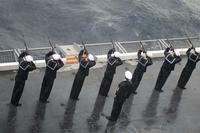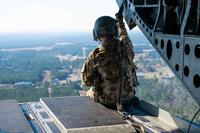In late 1970s, the U.S. military was almost a "hollow force," the Joint Chiefs said at the time, in part because of low pay, housing allowances set far below off-base rents, and anemic travel reimbursements that put service families in financial holes with every move to a new duty station.
These days the Joint Chiefs fear another hollow force. But this time the cause in part, they say, is Congress being too protective of military compensation while defense spending overall is under siege.
Ranks are full. Recruiting and retention are strong. But money to train, to support reasonable troop levels, to operate ships and aircraft, to maintain facilities and equipment, is being squeezed hard.
The biggest culprit is sequestration from the 2011 Budget Control, which automatically cut $37 billion from defense in March. Until Congress in July allowed a $9 billion shift from acquisition accounts into operations, Army had to suspend combat training center rotations except for units bound for Afghanistan, Navy cancelled an aircraft carrier group deployment and Air Force had grounded many stateside aircraft squadrons.
Another $52 billion is to be cut in fiscal 2014, which begins Oct. 1, followed by $50 billion more in each of the next eight years. It's a readiness hole that's "getting worse every day and we ignore it at our peril," warned Adm. James A. Winnefeld, vice chairman of the Joint Chiefs, in testimony to the House Armed Services Committee last week.
Winnefeld appeared with Deputy Defense Secretary Ashton Carter to present findings of the Strategic Choices and Management Review (SCRM). Led by Carter, the review produced options from the Joint Chiefs, combatant commanders and service secretaries to handle several budget cut scenarios.
The worst case would be full sequestration, requiring defense cuts of $500 billion over a decade, on top of $600 billion in defense cuts already accepted by Congress and reflected in current budget planning.
Adding to the risk, military leaders contend, is lawmakers' refusal to slow compensation growth and to cut excess overhead, including unneeded bases and older ships and aircraft.
"If we don't act together, the cost of manning the U.S. military and the civilians who support it will continue to grow at a rate that squeezes out budgets for training and modernization, resulting in a ‘hollowing out' of the force," said Carter.
Winnefeld urged Congress to partner on limiting the damage to force structure, modernization and readiness by giving DoD "freedom to find savings in our structural costs and our compensation first."
At risk of muddling their message, Carter said no one in uniform is overpaid for what they do, before explaining how critical it is that pay and benefits be brought under control.
"Compensation now makes up more than half of the defense budget," Carter said. "If overhead and compensation continue to grow as the overall budget shrinks, then all of the impact of the cuts will fall on the other parts of the defense budget – on force structure, on training for readiness and on investment in new technologies – resulting in reduced combat power and increased national security risk."
So far Congress can't abide higher TRICARE fees the administration seeks for working age retirees or the smaller raises planned for current forces. But Carter asked lawmakers to ponder what will happen to readiness without such concessions if the sequestration ax continues to fall.
The SCRM, he said, identified $63 billion in new efficiencies and $97 billion in compensation reforms needed under full sequestration. These include: more military and civilian pay caps; TRICARE changes to prod retirees to use employer health insurance; calculation changes to dampen housing allowance; smaller overseas cost-of-living adjustments; ending civilian pensions for retired military in federal civilian jobs; ending the $1.4 billion commissary subsidy, which would gut the benefit.
The ideas lack detail but seem intended to alarm Congress and service members, perhaps to spur lawmakers to cut a debt deal and end sequestration, perhaps to persuade military beneficiaries and their advocates to accept at least modest cuts to current compensation packages.
Carter conceded that these options would have a "significant impact" on service members. "But a sequestration-level scenario would compel us to consider these changes because there would be no realistic alternative that did not pose unacceptable risk to national security," he testified.
These are not yet Defense Department proposals. Defense Secretary Chuck Hagel has asked Army Gen. Martin Dempsey, chairman of the Joint Chiefs, to consider them in working with senior enlisted advisors to develop specific compensation initiatives that would cut almost $50 billion from military personnel accounts over the decade. Hagel is having his own staff do the same for civilian compensation accounts.
Also studying compensation reform, Carter said, will be the nine-member Military Compensation and Retirement Modernization Commission, established under last year's defense bill.
Rep. Joe Wilson (R-S.C.), chairman of the military personnel subcommittee, has opposed every attempt to slow military pay raises or to boost TRICARE fees. He surprised witnesses this day by asking, deep into the hearing, if the White House would continue to try to cap the next raise at one percent versus 1.8 percent needed to match civilian sector wage growth.
It's in the president's budget for 2014, so, yes, Winnefeld said.
Wilson also challenged the department's claim that military compensation growth has exceeded inflation by 40 percent since 2001, asking to see how the number was calculated.
"You would think the Joint Chiefs would be last group that would want to slow the rate of compensation," Winnefeld told Wilson. But the chiefs took a hard look at future budgets and concluded if raises aren't slowed "we are just going to run out of money to provide the tools troopers need."
The best compensation for warriors, Winnefeld added, "is to bring them home alive. The best way to bring them home alive is to get them the stuff they need."
To comment, write Military Update, P.O. Box 231111, Centreville, VA, or email milupdate@aol.com or twitter: Tom Philpott @Military_Update







